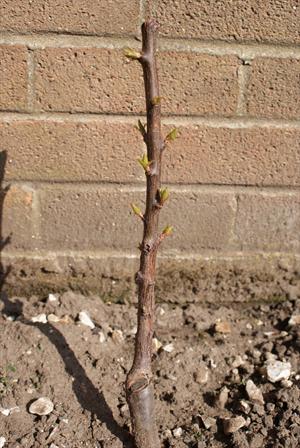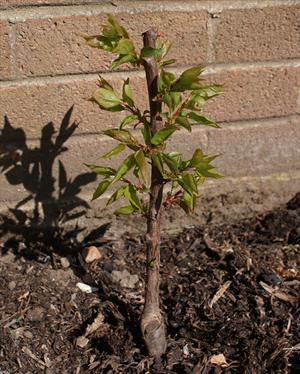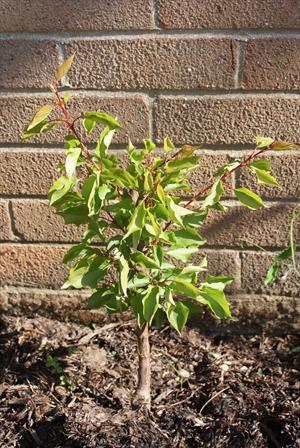Fans and espaliers are popular ways of training fruit trees to grow against a wall or on a trellis. Most apple and pear varieties which produce their fruit on spurs (rather than on the tips of their branches) can be trained as espaliers. Plums, cherries, apricots, peaches, and nectarines are not suitable for espalier-training, but do very well when trained as fans. Apples and pears can also be trained as fans if required, and whilst fans may lack the formal style of espaliers, they are easier to maintain and a bit more productive.
Training fruit trees in this way can make a noticeable difference to the flavour of the fruit, compared with free-standing trees. Fruit size is sometimes better as well because there tends to be fewer fruit, and also the tree may be putting more of its energy into the fruit rather than vegetative growth.
We offer a small range of pre-trained fans and espaliers (click here for details). However it is quite easy - and very satisfying - to carry out the formative training yourself. The following instructions are for training a fruit tree as a Y-shaped fan, consisting of a short central stem and then two primary arms, from which all the other branches radiate. You should start with a 1-year bare-root or 1-year container-grown tree. Within a few years you should have a very productive fruit tree which will be a real asset to your garden.
Benefits of fan-training and espalier-training
There are several reasons for training a fruit tree as a fan against a wall or trellis:
- The fruit receives more light, which helps improve development of natural sugars and fruit colour.
- If you are training against a south-facing brick wall, the micro-climate allows you to grow varieties that would normally require a warmer climate.
- You are naturally restricting the crop compared with a free-standing tree, and this can also help to improve flavour.
- Protecting the tree e.g. from frost or birds, is relatively easy.
- As well as productive capacity, fans and espaliers have an appealing ornamental value in the garden.
Choice of variety and rootstock
All plums, mirabelles, peaches, nectarines, apricots, quinces and cherries can be grown as fans, but not as espaliers. In addition most apples and pears can also be trained as fans or espaliers, but avoid tip-bearing apple varieties - if in doubt, ask us before ordering. Since part of the reason for growing fruit trees in this way is to maximise flavour and especially sweetness, it is best to choose fruit tree varieties which will take full advantage. Dessert plums, pears, quinces, and premium apples are especially suitable, whereas you are likely to see less benefit from growing, for example, culinary apples or culinary plums this way.
For plums, mirabelles, apricots, peaches, nectarines the best rootstock is St Julien A (or Torinel).
For apples, growers in the UK will probably prefer the MM106 rootstock. M26 can also be used, and will produce a slightly smaller tree. In the USA MM106 is usually considered too vigorous for espaliers (since most US climate zones have a longer growing season than the UK) and semi-dwarf or even dwarf rootstocks are more suitable.
For pears and quinces, choose a semi-dwarf or semi-vigorous rootstock.
How much space should you allow for a fan-trained or espalier-trained tree?
This can be quite difficult to predict as the rootstock, soil, and natural vigour of the fruit tree variety all play a part.
As a rough guide, the medium vigour rootstocks (apple MM106, plum St. Julien A, pear Quince A, cherry Gisela 5 or 6) will produce a tree which will occupy a width of about 10ft / 3m or more and a height of 8ft / 2.5m, after 5 years or so.
You can control the relative width and height to some extent as the tree grows, to suit the space you have available. So if you have a fence which is only 6ft / 2m tall, allow a bit more width and encourage the tree to put its energy into growing sideways rather than upwards.
If you have a typical 6ft fence and limited width (or you want to plant several trees together) then the more dwarfing rootstocks can be used.
In the UK the ideal location is a south-facing brick wall because of the warm micro-climate provided by the wall. South-east or south-west facing are also good orientations. East-facing and north-facing orientations are only possible in the case of certain fruit tree varieties which can cope with this tough situation. If you are preparing a trellis in open ground then a north-south orientation is worth considering. A trellis does not create the micro-climate of a wall, but on the other hand light can reach the fruit from both sides.
How to train a fruit tree as a Y-fan
If you have not trained a fruit tree before, the Y-fan is the easiest form to try because it looks very impressive but actually requires very little skill!
Start by ordering a 1-year "maiden" fruit tree. 2-year trees can be used but are not ideal. Planting is best done either in November or early spring depending on your climate situation - but choose a mild day and check the weather forecast to see that no frost or cold weather is likely for the next few days. The training process must be carried out when the tree is still dormant, once spring has got under way in your area, it is too late.
Prepare a planting hole in the normal way - for general information on planting, see our planting directions. If training against a wall, the tree should be planted at 8" - 12" from the wall. If you are concerned about the roots damaging the foundations you can plant up to 24" away if necessary, and angle the tree towards the wall.
Place the tree in the hole. Try to spread the roots outwards and downwards away from the wall. Note the position of the distinctive kink on the stem of the tree - this is the graft union (where the fruiting variety joins the rootstock). Ideally the graft union should be on the wall-side of the hole.
Once the tree has been planted, you need to cut the stem down quite drastically, to form the bottom leg of the "Y". Don't worry if you feel you have just planted a 6ft tree and are now throwing most of it away - it will grow back very quickly. This is the only part of the process which requires any real skill, so pay attention! The cut is performed at a height of roughly 12"-20" / 30cm-50cm from the graft union, but the height is less important than choosing the right point, just above 2 buds on either side of the stem, and parallel to the wall. NB. Make sure you have plenty of buds below the point where you intend to cut. It is these buds which will form the arms of the "Y". If there are too few buds the process will not work.
The cut should be performed at a slant away from the top-most of these 2 buds. Study the photograph carefully and find a similar point on your tree, then make the cut with sharp secateurs - be decisive and cut cleanly. It is a very good idea to practice higher up the tree first.
Note that in the UK it is generally recommended not to prune plums, peaches, nectarines, mirabelles and damsons in winter - but this is an exception. In the USA this initial pruning should be done at the time of planting in early spring in most zones.



The sequence of photos above shows how the cut-down stem responds in the spring and summer following planting. As can be seen you will probably find several shoots start to emerge, and not always where you hoped! It is worth letting these grow for a few months as they help the tree gain strength. By mid-summer it is probably clear which branches are best suited to forming the arms of the "Y" and you can remove any major competing shoots. If one shoot is much stronger than all the others, do not use it, but instead remove it - it is best to start the framework with 2 shoots that are of equal size. At this stage you might also need to adjust the angle of the arms by tying them to bamboo canes, although whilst they are still young and pliable it is sometimes worth letting them have a period of growing more vertically (this encourages growth). The only major issue to be aware of is that one arm (often the one nearest the top of the stem) may start to dominate the other, and it is worth keeping a close eye on this - if it starts to happen, you can weaken it by tying it horizontally whilst letting the weaker arm grow more vertically for a period.
